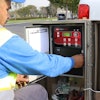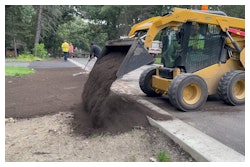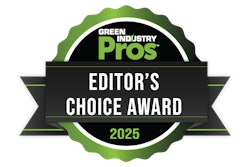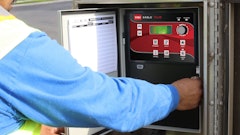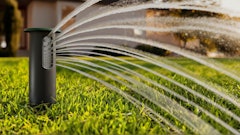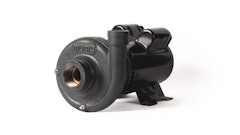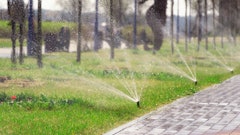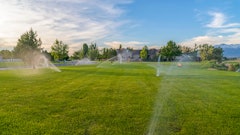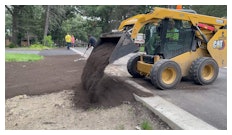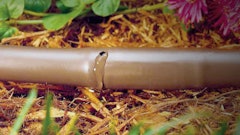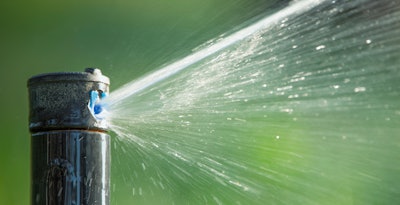
Few developments have affected landscape irrigation like the push to require pressure-regulated spray technology, commonly referred to as PRS regulations. While irrigation professionals have long understood the connection between water pressure and spray efficiency, new regulations and emerging technologies are now making pressure regulation not just a best practice, but often a legal requirement.
Across the U.S., municipalities and state agencies are beginning to mandate PRS-compliant spray heads as part of broader water conservation efforts. For irrigation professionals, this shift brings both opportunities and challenges. Understanding the implications of these changing regulations is key to staying compliant, staying competitive, and ultimately delivering better results for customers.
Pressure-Regulated Spray Heads Basics
PRS spray heads are sprinkler bodies equipped with internal pressure regulators that maintain a constant water pressure. Optimum pressure for spray nozzles is around 30 psi and 40 to 50 psi for multi-stream rotating nozzles. These components can reduce the effects of high or fluctuating water pressure, including misting and uneven coverage, both of which lead to inefficient water use and poor results.
Maintaining a consistent pressure across the system translates directly into improved irrigation efficiency, lower water bills, and better plant health.
The Regulatory Push
Maintaining a consistent pressure across the system translates directly into improved irrigation efficiency, lower water bills, and better plant health.
In 2020, the U.S. Environmental Protection Agency (EPA) stipulated that spray bodies must include internal pressure regulation to qualify for WaterSenseâ labeling. Since then, CA, CO, HI, MA, MD, ME, NJ, NV, NY, OR, RI, VT, WA, and Washington DC have passed legislation requiring the use of PRS-compliant sprinkler bodies in new and retrofit projects. This change is particularly significant in states like CA that are facing chronic drought conditions and tight water-use restrictions.
For irrigation contractors, these regulations are not simply compliance checkboxes. They represent a pivotal shift in design standards, product selection, and overall system performance expectations.
 SiteOne Landscape Supply
SiteOne Landscape Supply
Improved Efficiency & Water Savings
Studies have shown that properly pressure-regulated systems can reduce water use by up to 30% compared to non-regulated systems.
Switching to PRS-compliant equipment offers irrigation professionals important benefits and advantages. One primary benefit of switching to PRS technology is greatly increased water efficiency. Excess water pressure above a nozzle’s optimal operating range causes misting. The water simply turns into a fine vapor and drifts away in the wind or evaporates before reaching the soil.
By regulating pressure to a consistent level, PRS spray bodies eliminate waste caused by misting and deliver water more precisely and uniformly. Studies have shown that properly pressure-regulated systems can reduce water use by up to 30 percent compared to non-regulated systems.
This can quickly add up to significant water and cost savings, especially for larger commercial landscapes, parks, and HOAs. And for customers concerned about sustainability goals or rising water bills, increased efficiency is an easy selling point.
More on Irrigation Systems on GreenIndustryPros.comBest Practices for Smart Irrigation System Management - Close the gap of irrigation system maintenance with sensors, balanced rotor nozzles, head-to-head coverage and more, for smart water management. Choosing the Right Irrigation System Components - A few guidelines to help irrigation professionals choose the right components for their systems. All Systems Go: A Guide to Smart Irrigation Systems - Irrigation experts lay out why a smart irrigation system involves more than just a smart controller. |
Fewer Callbacks & Maintenance Issues
Inconsistent pressure doesn't just create waste; it creates headaches. High-pressure systems often result in damaged nozzles, irregular spray patterns, and zones that flood or dry out unpredictably. The consequences are uneven turf, stressed plantings, and an uptick in service calls from frustrated property owners.
With PRS equipment, systems are inherently more balanced and predictable. Irrigators can design with greater confidence, knowing that each head is operating within its optimal pressure range regardless of the system’s variability upstream. This translates into fewer site visits to troubleshoot overwatering, less time adjusting heads manually, and improved system longevity.
In a tight labor market, those saved hours matter. Crews can focus on proactive system audits, upselling smart controllers or drip retrofits, and moving on to the next job instead of spending lots of time on recurring pressure-related problems on a previous job.
For public-sector bids or budget-conscious projects, contractors may face pressure to justify using higher-cost PRS systems.
Higher Upfront Costs & Installation Learning Curve
New technology often has growing pains associated with it. For many professionals, the most immediate downside of switching to PRS-compliant equipment is the increased cost, both in equipment and sometimes in installation labor.
PRS heads typically cost more than standard heads, with prices varying by brand and model. The long-term water savings will eventually outweigh the initial investment. However, some professionals, as well as their customers, may be focused mostly on costs and be reluctant to pay for the more expensive equipment and service. Both groups can benefit from learning more about PRS systems. For public-sector bids or budget-conscious projects, contractors may face pressure to justify using higher-cost PRS systems.
But changing to PRS equipment offers a lot of positives. A 20 percent reduction in water pressure at the nozzle results in a 10 percent reduction in gallons per minute in the flow. Replacing a 50-psi spray body with a 30-psi regulated spray body would give a 20 percent reduction in overall water usage. PRS sprinklers are often easily integrated into older non-regulated systems, and a whole site upgrade can be completed over time as budgets allow. Each new PRS sprinkler added in will improve the efficiency and uniformity of the site.
This learning curve, while not steep, still represents a cultural shift for crews used to traditional heads and installation protocols.
 SiteOne Landscape Supply
SiteOne Landscape Supply
Where the Industry Is Headed
The momentum behind PRS is unlikely to slow. PRS-compliant products can offer options like check valves and internal flow regulation to provide even more water savings. As more states adopt WaterSense-aligned regulations, the PRS standard will continue to evolve from a forward-looking best practice into a day-to-day baseline.
Rather than waiting for regulations to mandate PRS technology, irrigation professionals can lead conversations about PRS-compliant products with clients and present themselves as a conservation-focused partner. Those who adapt early will be better equipped to deliver consistent results, meet regulatory benchmarks, and differentiate themselves in the marketplace.



